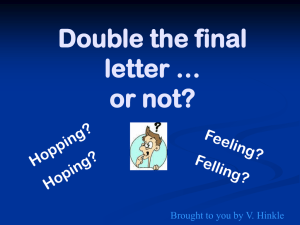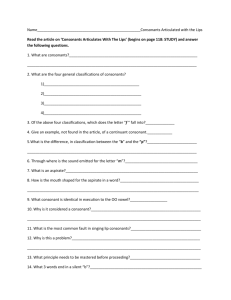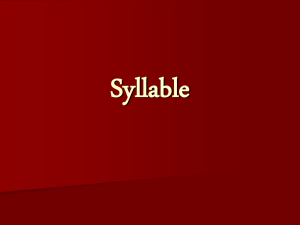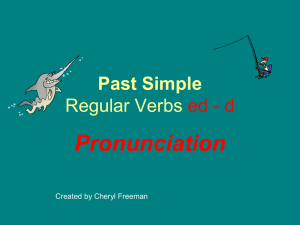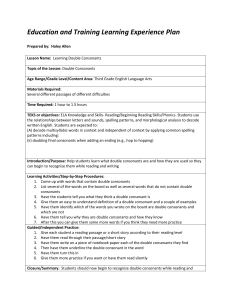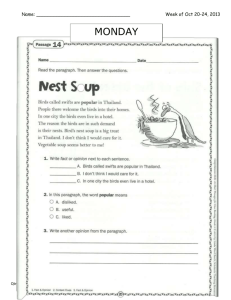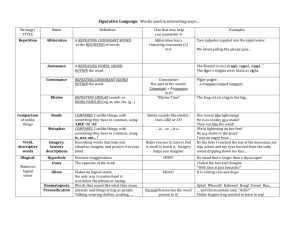SUBJECT: Reading Topic/Title: Consonants & Alphabet in Motion
advertisement
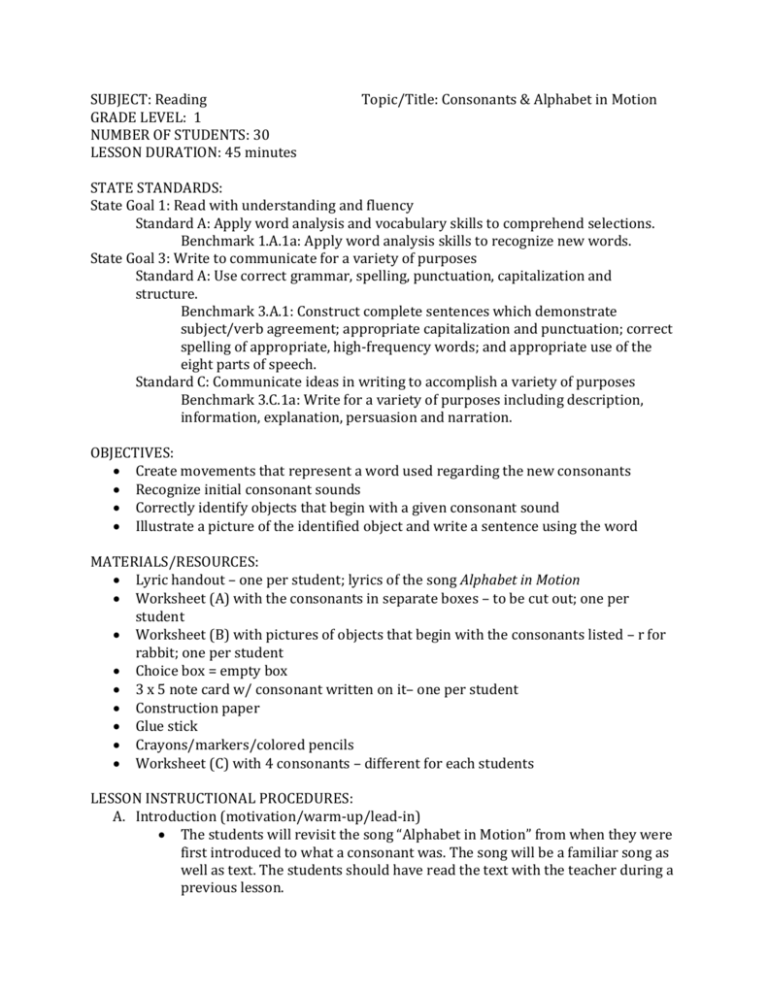
SUBJECT: Reading GRADE LEVEL: 1 NUMBER OF STUDENTS: 30 LESSON DURATION: 45 minutes Topic/Title: Consonants & Alphabet in Motion STATE STANDARDS: State Goal 1: Read with understanding and fluency Standard A: Apply word analysis and vocabulary skills to comprehend selections. Benchmark 1.A.1a: Apply word analysis skills to recognize new words. State Goal 3: Write to communicate for a variety of purposes Standard A: Use correct grammar, spelling, punctuation, capitalization and structure. Benchmark 3.A.1: Construct complete sentences which demonstrate subject/verb agreement; appropriate capitalization and punctuation; correct spelling of appropriate, high-frequency words; and appropriate use of the eight parts of speech. Standard C: Communicate ideas in writing to accomplish a variety of purposes Benchmark 3.C.1a: Write for a variety of purposes including description, information, explanation, persuasion and narration. OBJECTIVES: Create movements that represent a word used regarding the new consonants Recognize initial consonant sounds Correctly identify objects that begin with a given consonant sound Illustrate a picture of the identified object and write a sentence using the word MATERIALS/RESOURCES: Lyric handout – one per student; lyrics of the song Alphabet in Motion Worksheet (A) with the consonants in separate boxes – to be cut out; one per student Worksheet (B) with pictures of objects that begin with the consonants listed – r for rabbit; one per student Choice box = empty box 3 x 5 note card w/ consonant written on it– one per student Construction paper Glue stick Crayons/markers/colored pencils Worksheet (C) with 4 consonants – different for each students LESSON INSTRUCTIONAL PROCEDURES: A. Introduction (motivation/warm-up/lead-in) The students will revisit the song “Alphabet in Motion” from when they were first introduced to what a consonant was. The song will be a familiar song as well as text. The students should have read the text with the teacher during a previous lesson. i. Hand-out a copy of the lyrics: Learn the abc's with ease While getting fit and having fun Alphabetize your exercise And do your moves one by one At the store or in the park You'll cause a small commotion If you suddenly stand and start The alphabet in motion A arch B bend C clap D droop E expand F flop G grow H hop I itch J jog K kick L leap M march N nod O open P prance Q quake R rock S squat T turn U uncurl V vibrate W walk X make an X shape Y yawn Z zig zag ii. Have the students listen to the song “Alphabet in Motion”. 1. As the students listen to the song have them move along to it. They can dance, shake, and bounce to warm up during the first verse. They can then create motions that go with a word for each letter of the alphabet; such as making an arch for “a”. B. Development: Instruction and Activities Begin by passing out worksheets A and B. Model the activity. i. “I have already cut out all my consonants. I have one consonant. It is the letter R. I must now find a picture of an object that begins with the consonant I have in my hand. The picture right here is a rabbit. ‘Rabbit’ starts with the consonant letter R. I will now glue the “r” right below the picture of the rabbit.” ii. Then, have the students first cut out the boxes with the consonants in them – worksheet A. iii. Each student will then paste the consonants right below the picture/object that begins with that consonant – worksheet B. After the students have completed worksheet B, have them choose a 3 x 5 note card from out of the choice box. The choice box contains the consonant letters. i. The students will have to find an object in the room that begins with the consonant they chose out of the choice box. ii. On a piece of construction paper they must write “I found a(n) ________ and a(n) __________ starts with the letter ______.” Students must also include an illustration of the object they chose. The students will then work on worksheet C – explained under “differentiated assessment”. C. Differentiated Instruction ELL i. The students will be provided a dictionary, extra examples for each consonant, and will be allowed to work in pairs. Special Education – mild-moderate memory and processing learning disability i. Worksheet B will be broken up in to different sections, each section will tell you the four consonants that belong to the object/picture without giving you the answer. This allows fewer choices for the students to focus more on correctly matching the consonant to the picture/object. Talented and Gifted i. Worksheet B will have pictures of objects/pictures that are slightly more difficult. The amount of work will be the same but the level of difficulty will have been increased slightly. D. Closure Each student will present his or her consonant and picture. They must read the statement written on the construction paper and explain their picture. As a class, the students will discuss the new consonants sounds. As a last minute review the teacher will say each consonant covered in the lesson in a random order and have students take turns responding with the name of an object/ letter that starts with that consonant. DIFFERENTIATED ASSESSMENT for ELL, LD, Gifted, and General Education Informal – o ELL The teacher will assess worksheet B for correct matching, consonant to object/picture. The teacher will also keep track of each students’ participation during the presentations of consonants. Each student who worked in a pair will have to explain how they got one of the matching on worksheet B. o Special Education – mild-moderate memory and processing learning disability The teacher will assess worksheet B for correct matching, consonant to object/picture. The teacher will also keep track of each students’ participation during the presentations of consonants – this can be done individually with the student and teacher or with the whole class. o Talented and Gifted The teacher will assess worksheet B for correct matching, consonant to object/picture, while asking the students to explain how they reached their answers. The teacher will also keep track of each student’s participation during the presentations of consonants. o General Education The teacher will assess worksheet B for correct matching, consonant to object/picture. The teacher will also keep track of each students’ participation during the presentations of consonants. Formal – Worksheet C o ELL Provide each student with 4 different consonants. They must come up with one picture/object per consonant. Ask the students to ask themselves, “Can you find other words that begin with each letter? Along with the picture, the students must write the following: “I found a(n) _____________ and a(n) ______________ starts with the letter ______.” They must do this for each consonant. Have the students work in pairs if needed. o Special Education – mild-moderate memory and processing learning disability Provide each student with 3 consonants. They must come up with one picture/object per consonant. Ask the students to ask themselves, “Can you find other words that begin with each letter? Along with the picture, the students must write the following: “I found a(n) _____________ and a(n) ______________ starts with the letter ______.” They must do this for each consonant. The students are required to do slightly less work while still showing what they have learned from the days lesson. o Talented and Gifted Provide each student with 4 different consonants. They must come up with one animal per consonant. Ask the students to ask themselves, “Can you find other words that begin with each letter? Along with the picture, the students must write the following: “I found a(n) _____________ and a(n) ______________ starts with the letter ______.” They must do this for each consonant. This provides a more challenging activity without adding more workload. o General Education Provide each student with 4 different consonants. They must come up with one picture/object per consonant. Ask the students to ask themselves, “Can you find other words that begin with each letter? Along with the picture, the students must write the following: “I found a(n) _____________ and a(n) ______________ starts with the letter ______.” They must do this for each consonant. REFLECTION/NEXT STEPS I would like to turn this lesson in to a daily game. It could be like an I Spy type of game. “I spy with my eyes something that starts with the letter _____.” REFERENCES http://amiegebhardt.com/downloads/AmieGebhardtLesonPlan1.pdf http://www.songsforteaching.com/happalmer/alphabetinmotion.htm


